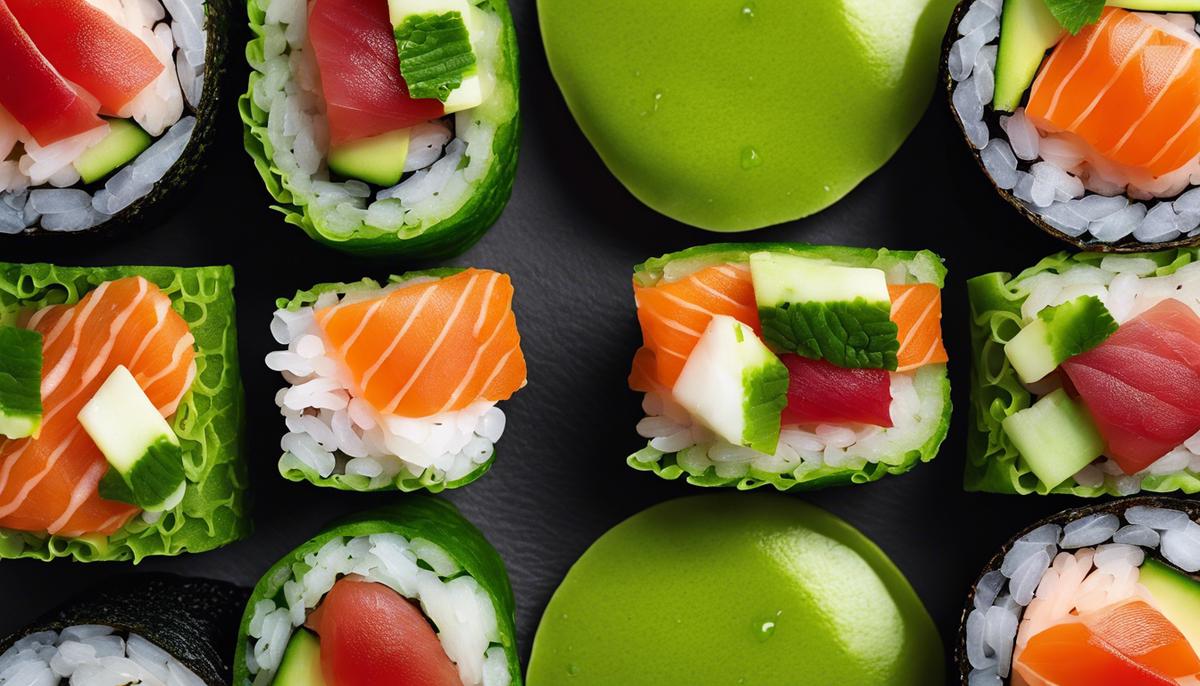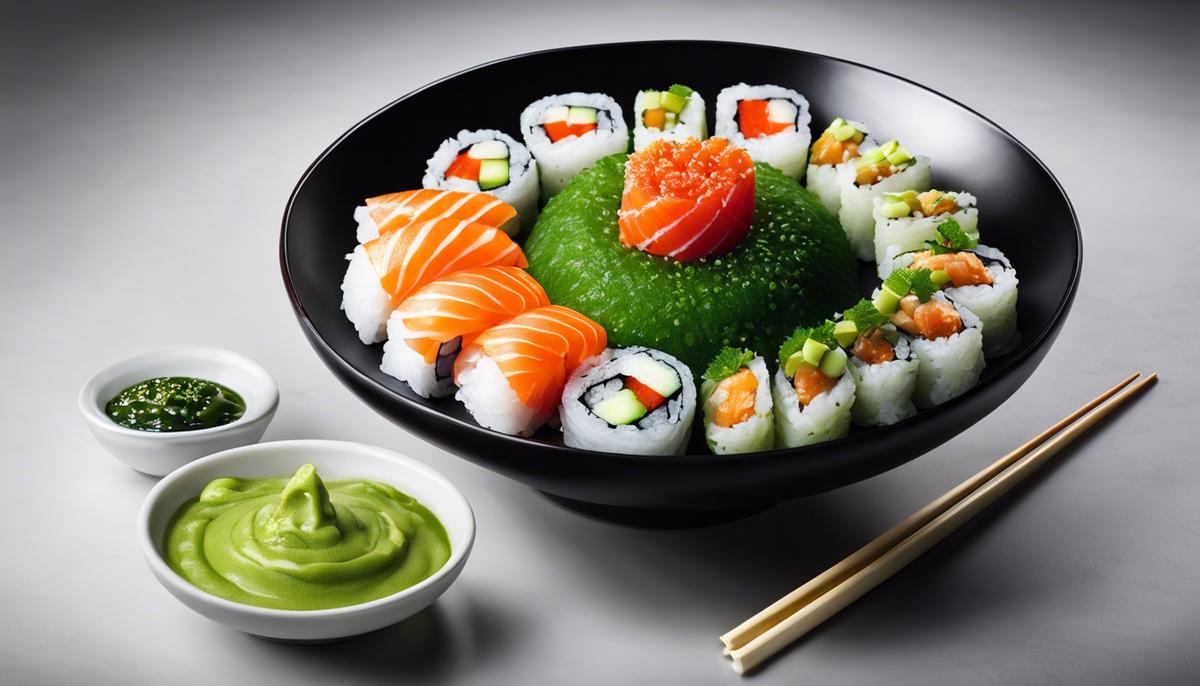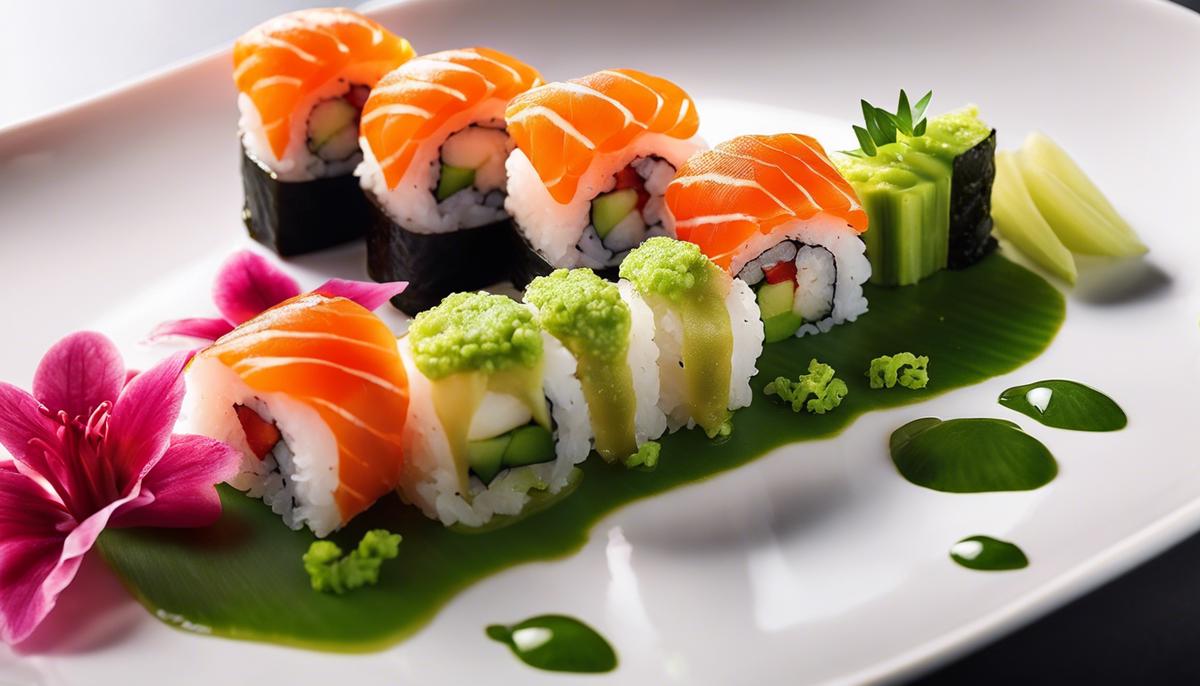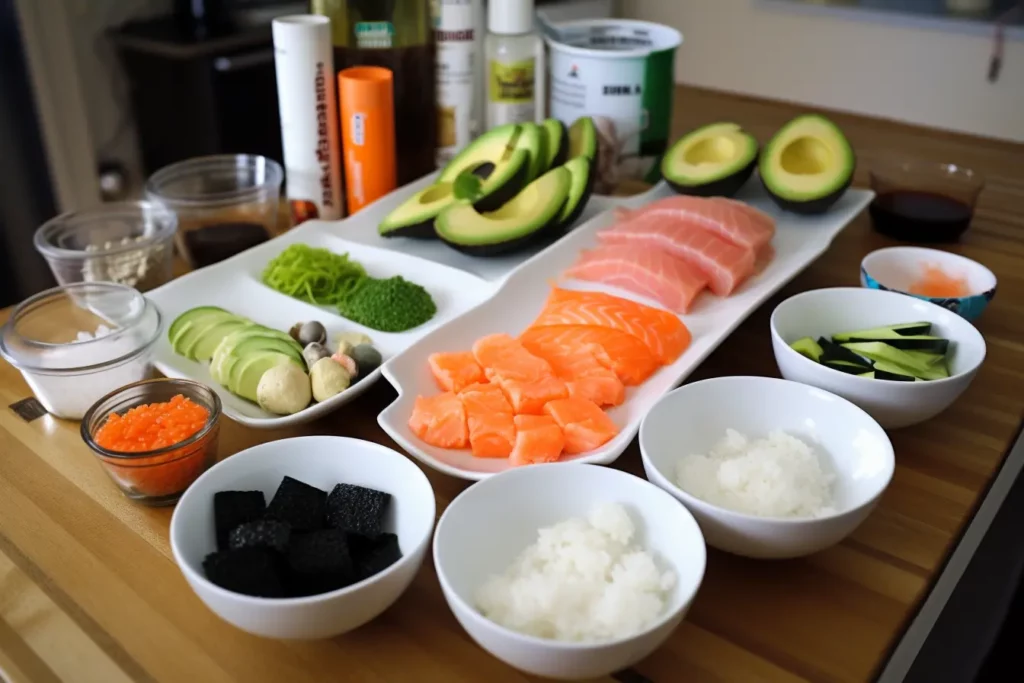Eating sushi is a millennia-old tradition that dates back to the roots of Japanese culture. While in Western cultures, sushi is often seen as simple rice and raw fish, in Japanese culture it is so much more. Among them is an ingredient that cannot be underestimated in its importance – wasabi. The green, fiery paste that breathes life into any sushi plate is deeply embedded in the tradition and history of Japan. The appreciation of wasabi extends far beyond its distinctive flavor and is an integral part of Japanese cuisine and culture. Here, we take an in-depth look at the origin of wasabi, its health benefits, the art of its application, and the sad reality of its fake.
The origin and tradition of wasabi
Title: The Roots of Wasabi: An Essential Accent in the World of Sushi
The gentle arc of a sashimi piece, the precision of a Nobiri roll—there’s something deep-end appealing about the minimalist beauty of sushi. But where would this culinary masterpiece be without the green dab of wasabi? This distinctive, pungent spice is an integral part of the sushi experience for many. But where does this tradition actually come from? Let’s dive into history.
Wasabi has been a staple in Japanese food culture for centuries. Wasabi’s antiseptic properties made it an invaluable companion for raw fish, which, if not handled properly, can spoil easily. Even before the advent of today’s sushi style in the 19th century, the Japanese seasoned their raw fish with wasabi.
Spreading wasabi between fish and rice helps neutralize unwanted fish odors and gives the sushi a spicy yet refreshing touch. Note that real wasabi extracted from the Wasabia japonica plant tends to have a sweetish pungent aroma that varies greatly from the pungent taste of the wasabi alternatives more commonly used in the West.
However, the current trend of adding wasabi to soy sauce is less traditional and rarely practiced in Japan. The aim here is to soften the intensity of the wasabi spiciness and, in combination with the salty soy, to create a spicy addition to the sushi.
Obviously, wasabi subtly stimulates the overall sensory experience of eating sushi – a perfect balance of taste, texture and presentation. It’s not just a habit, it’s a tradition that was born out of simple practicality and has now become an integral part of the global sushi experience.
So, the next time you have that massive piece of sushi in front of you, take a moment to appreciate the green dab of wasabi. It’s more than just a sharp companion – it’s a link to a centuries-old tradition that makes its way straight from the heart of Japan to our fashionable sushi restaurants and Instagram feeds. The spice of the wasabi perfectly enhances the tender sushi and offers a glimpse into the deep, rich culture from which it originates.

The Health Benefits of Wasabi
To continue talking about the health benefits of this intriguing spice, the substance called isothiocyanate takes center stage. This substance is responsible for the pungent taste of wasabi and is just as helpful in the fight against inflammation in the body. A small but constant bite of wasabi on your sushi and you’ll feel your sinuses clear in a flash.
But it doesn’t stop there. Scientific studies have shown that wasabi has potential to inhibit the growth of certain bacteria and even cancer cells. These properties can protect against health problems such as food poisoning from raw fish or even serious diseases such as cancer.
But beware – too much spicy wasabi can make you unaware of the subtle taste of high-quality sushi. It is art to find the balance between the intense flavor of wasabi and the delicacy of the other ingredients.
Wasabi also has antioxidant properties. These help to reduce oxidative stress and thus the risk of chronic diseases. In addition, the plant can also help minimize the risk of cardiovascular disease by inhibiting platelet aggregation.
In terms of nutrition, wasabi is very low in calories but contains a good amount of fiber. So, your diet could benefit from a little pinch of wasabi while delighting your taste buds.
Wasabi is by no means a simple spice, but a multi-layered companion that contributes to our sushi experience and also to health. Now that you know, why not enjoy your next sushi with a new appreciation for this green paste? Don’t forget to share your experience with us on our social media channels at #WasabiWighlights!

The taste and art of using wasabi
The health benefits of wasabi are just as impressive as the intense flavor that this plant brings. Extracted from the root of this plant, wasabi is not only an essential ingredient when consuming sushi, but it also offers numerous health benefits that make it a smart addition to any diet.
Of particular note is the substance called isothiocyanate in wasabi. This is responsible for the strong, pungent taste of wasabi, which even brings tears to some people’s eyes. But it offers more than just a taste sensation. Isothiocyanates are known to be powerful antioxidants and anti-inflammatories and can help relieve various health ailments.
Wasabi is also effective against bacteria and possibly even cancer cells. Its antibacterial properties make it ideal for consumption with raw fish, such as those found in sushi. In addition, studies show that wasabi can inhibit certain cancer cells, which only increases its popularity as a healthy eating option.
The balance between the intense wasabi flavor and the quality of sushi plays a crucial role. Too much wasabi can overwhelm the delicate flavor of sushi, while too little could minimize its health benefits and the interesting depth of flavor it adds.
In addition, the antioxidant properties of wasabi are remarkable. Antioxidants in our food help our body fight free radicals and can thus reduce the risk of chronic diseases and cardiovascular disease.
Finally, it is important to emphasize that wasabi is also low in calories and high in fiber. So, adding wasabi to your meal can help increase your satiety level without adding a lot of extra calories.
Wasabi is therefore not only an accompaniment to sushi and an exciting element in the kitchen, but also contributes significantly to health. In the spirit of a conscious, healthy and aesthetic lifestyle that we all aspire to, we should think of wasabi not only as a green paste that spices up our sushi, but also as an important part of a balanced, healthy diet.
In practice, this means exploring the intricacies of using wasabi in the kitchen to achieve the perfect balance – between taste and health, between modernity and tradition, between global and Japanese cuisine. And the most important thing: Experiment, experience and enjoy wasabi in all its facets!

The imitation and counterfeiting of wasabi
The search for authenticity in wasabi
As the catalyst for an exceptional dining experience, wasabi is a must-have in any well-stocked sushi bar. But do you really elevate the green blob to a pedestal of authenticity?
The truth is that real wasabi, known as Wasabia japonica, is a rare commodity – even in Japan. This plant gemstone is extremely difficult to grow, and its ideal habitat – the humid and cool mountain rivers of Japan – is limited.
The result? Much of the wasabi served in sushi restaurants worldwide is actually a mixture of horseradish, mustard powder, and artificial green color. The flavor of these substitutes is often sharper and less nuanced than that of the real wasabi.
However, there is no cause for concern, as this substitute is readily embraced by the majority of sushi lovers. Some even argue that the stronger flavor is better suited to the delicate nature of sushi, leaving the taste buds ready for the sushi piece that follows. Nevertheless, the experience of the real thing is incomparable and a treat for the senses.
The use of real wasabi is an expression of respect and appreciation for the cuisine and means that the restaurant places emphasis on quality and tradition. A shark skin grater, also called oroshigane , is used to transform the wasabi root into a fine paste, releasing the essential oils that create the unmistakable flavor.
So, it’s worth looking for restaurants that offer this authentic experience to their guests. In acknowledging and appreciating the differences between real wasabi and its more common substitute, we not only merge with the deep culture and traditions of Japan, but also give ourselves the freedom to personalize and enhance our own sushi experience. Real or not, wasabi remains an integral part of our sushi enjoyment.
Therefore, let’s celebrate the green paste on our plates, whether it’s real or not, because it’s an expression of our global connection with Japanese culture and its irresistible sushi. That’s the real beauty of wasabi – authentic or not.

On the surface, it may seem like wasabi is just another ingredient in the unbeatable combination of sushi, but it’s much more than that. Wasabi is a bright, glowing reminder of the history and culture that shaped sushi. It is a testimony to the attention to detail and respect that the Japanese have for their cuisine. Through the delicate hands of sushi masters and the warmth of Japanese hospitality, wasabi has found its way into sushi restaurants around the world and has become an indispensable companion to any sushi meal. Cherishing every bite of a piece of sushi with wasabi is not only paying tribute to its zesty spiciness, but also celebrating the thousand-year-old tradition it represents.


